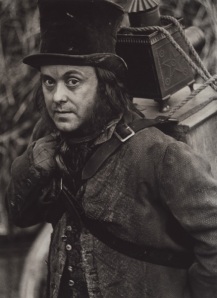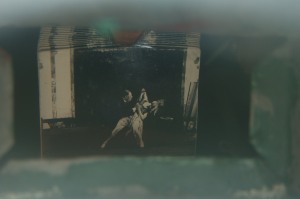
Promotional leaflet for ‘Spellbound: art and film’ at the Hayward Gallery (EXEBD 41644)
It is interesting comparing this article (written in 1996) with Christopher Kenneally’s 2013 documentary Side by Side, which looks at the advent of digital film images and the decline of celluloid. The exhibitions the article reviews seek to highlight how far film has come since its invention in the 1890s and the important and dominant role it plays in contemporary art. However, film itself has developed remarkably since its centenary celebrations. The introduction of digital film has begun to supersede its photochemical counterpart. This is due in part to its accessibility. Side by Side seeks to illuminate this transition in optical media by interviewing many of the world’s leading filmmakers and cinematographers and noting their preferred methods. It is clear to many though, even to those filmmakers who prefer traditional methods of film practice, that digital is fast becoming the dominant medium. Accessibility is democracy, the film points out, and democracy is becoming vital to the arts.
Visual art is as unsentimental as the high street in many respects. Nostalgia is saved for the museums, the galleries and the antique auction houses. The supersedure of art forms and the beguiling nature of more accessible optical media is the subject of my short film,The Lanternist. Lanternists, who were sometimes referred to as Savoyards or Galantys, were traditional small-time visual entertainers in the early 19th century. They would travel between villages and towns putting on magic lantern displays in public places or in the houses of the wealthy. However, their trade began to decline towards the end of the century, due in part to the mass-production of magic lanterns and slides which made it possible for families to organise private lantern displays in their own homes.
Alex Norton as The Lanternist in Bill Douglas’ ‘Comrades’ (EXEBD 60820)
Partly inspired by Alex Norton’s brilliant turn as an itinerant lanternist in Bill Douglas’ film ‘Comrades’, my short film portrays the galanty in a less than fortuitous light. However, unlike Bill’s Lanternist, who through the course of ‘Comrades’ takes on many different guises in order to tell the parallel stories of the history of pre-cinema and the struggles of the Tolpuddle Martyrs and who eventually appears as a successful showman in the final reel, the Lanternist in my film is tortured by the redundancy of his trade and desperately wanders the fringes of society searching for an audience. He engages in crazed and ritualistic dances as part of a defunct show that he performs to no one. He cuts a wraith-like figure walking a lonely pilgrimage. Along the way he finds discarded objects that reflect his own futility. I was inspired largely by Bill’s use of the Lanternist as a metaphorical figure in order to give his film a more harrowing visual, cultural and social context. In the final shot of my film I have included a Mutoscope display, that can be found in the Centre. The Mutoscope, like the Magic Lantern before it are all part of the progression in optical entertainment that has led to contemporary cinema as we know it today (my film is shot in digital). We should celebrate this progression, and indeed the progression of all art forms, and while innovation may be ephemeral it is vital to our culture. However, there are many Lanternists left behind along the way.
Magic Lantern Slides: Bluebeard (EXEBD 64515)
Image from inside The Bill Douglas Centre’s Mutoscope (EXE BD 69076)








